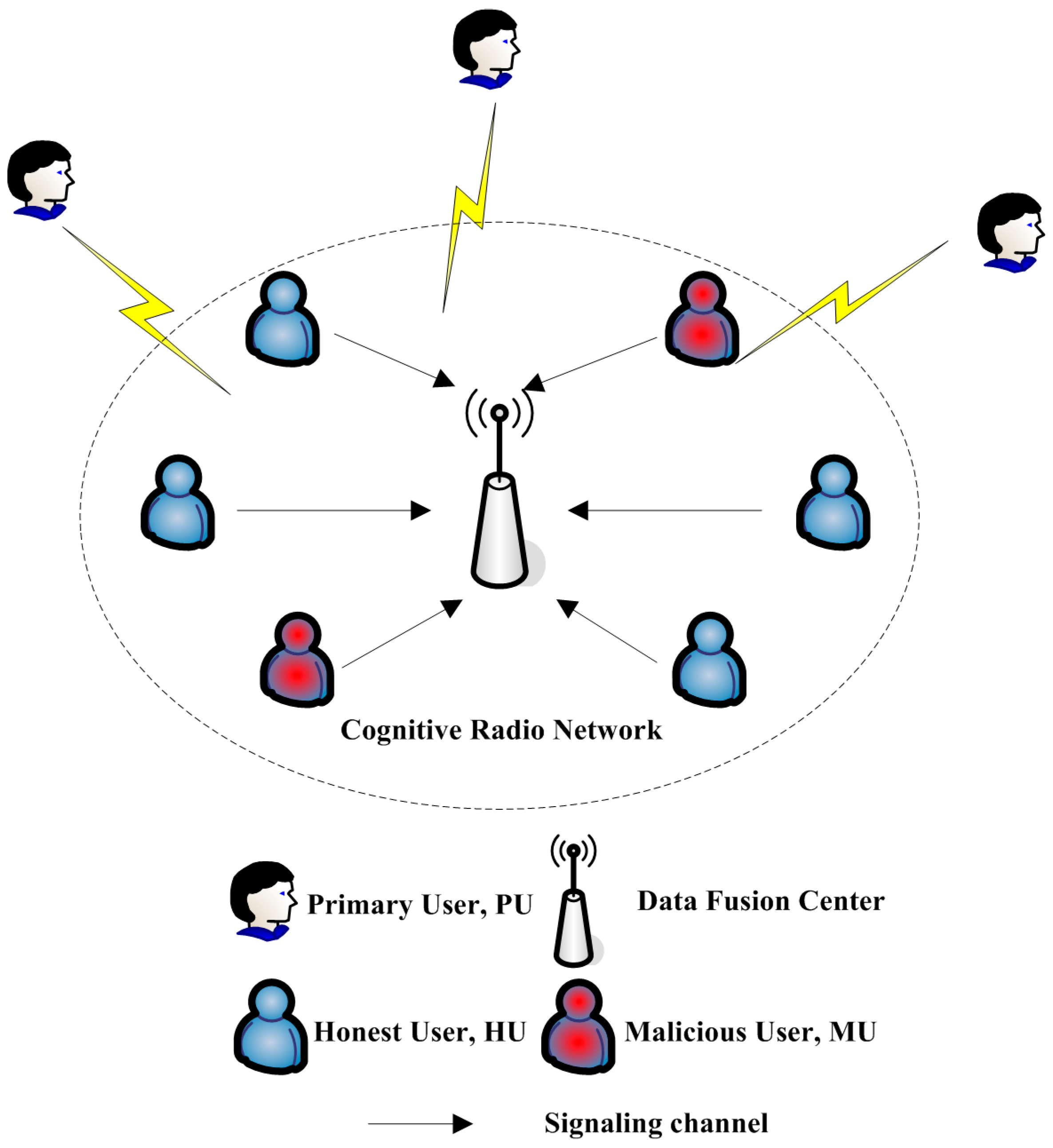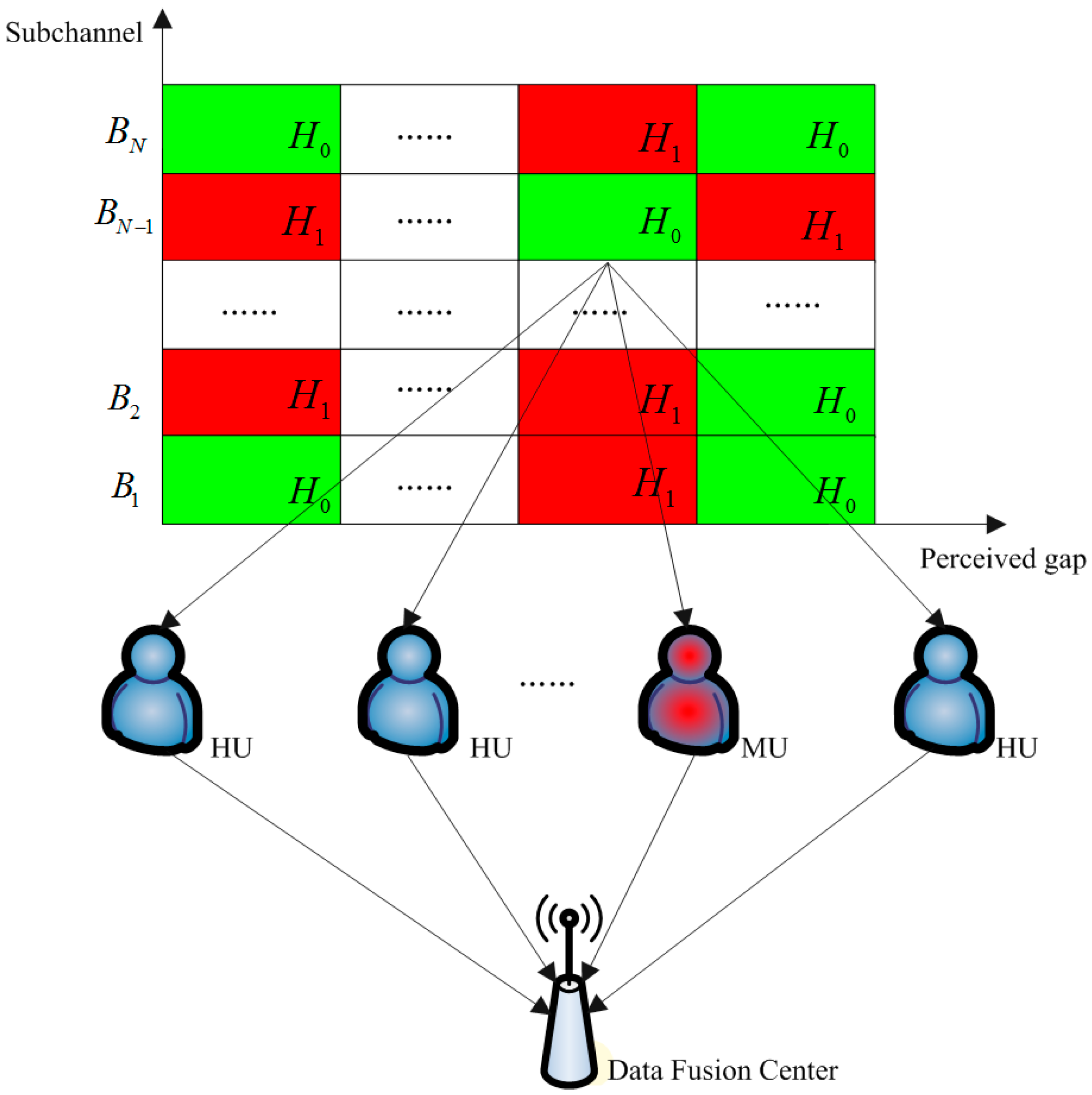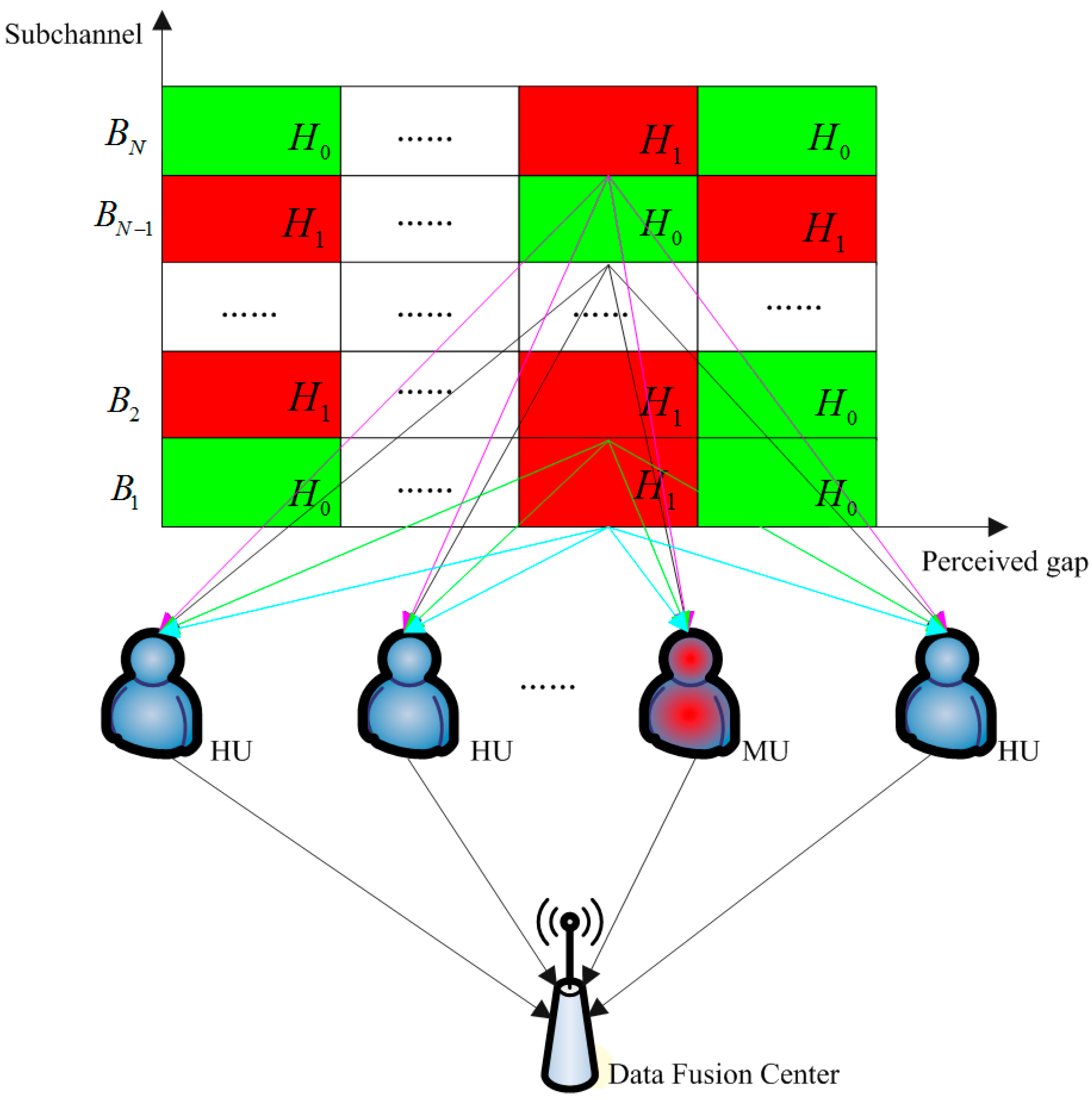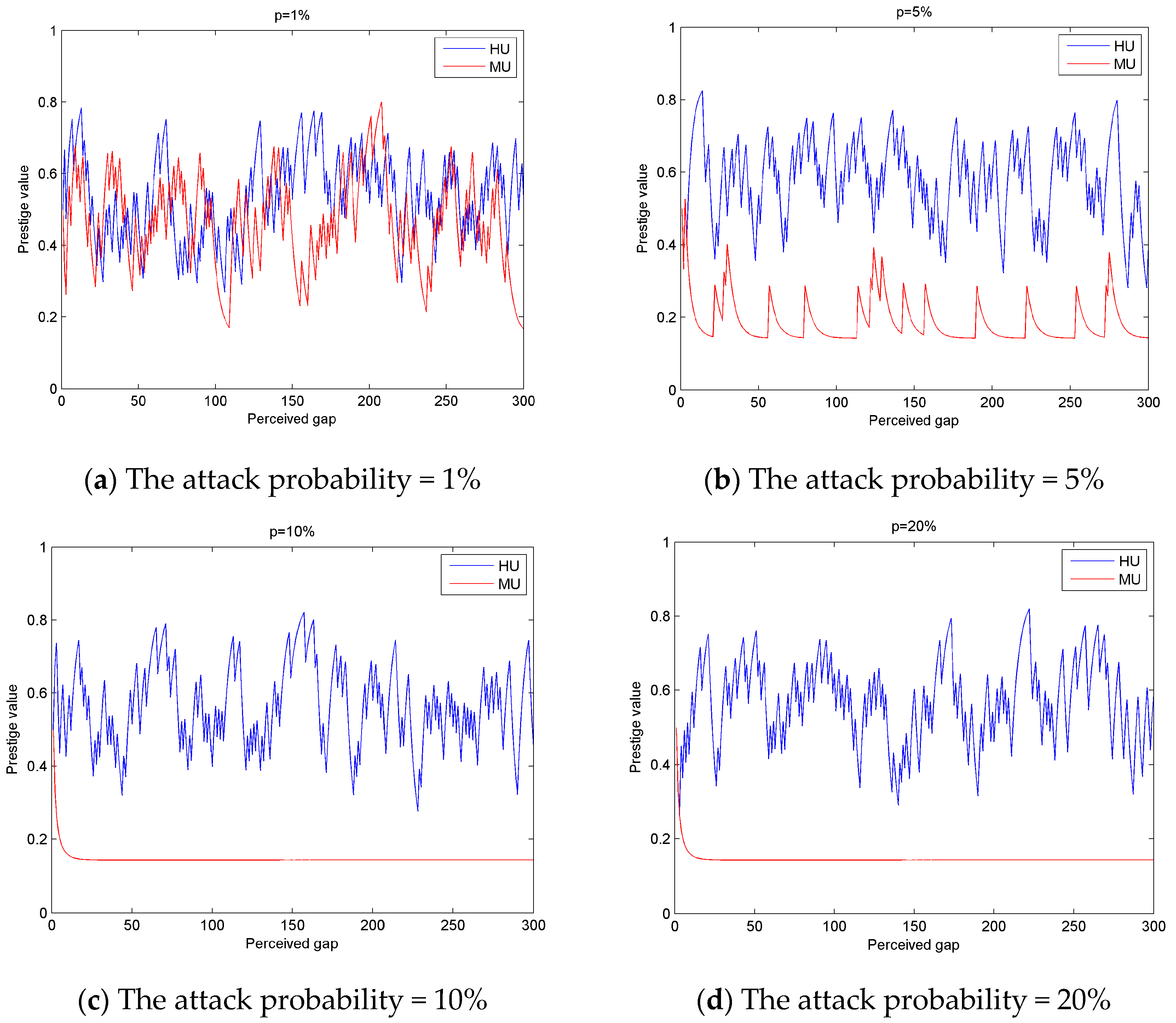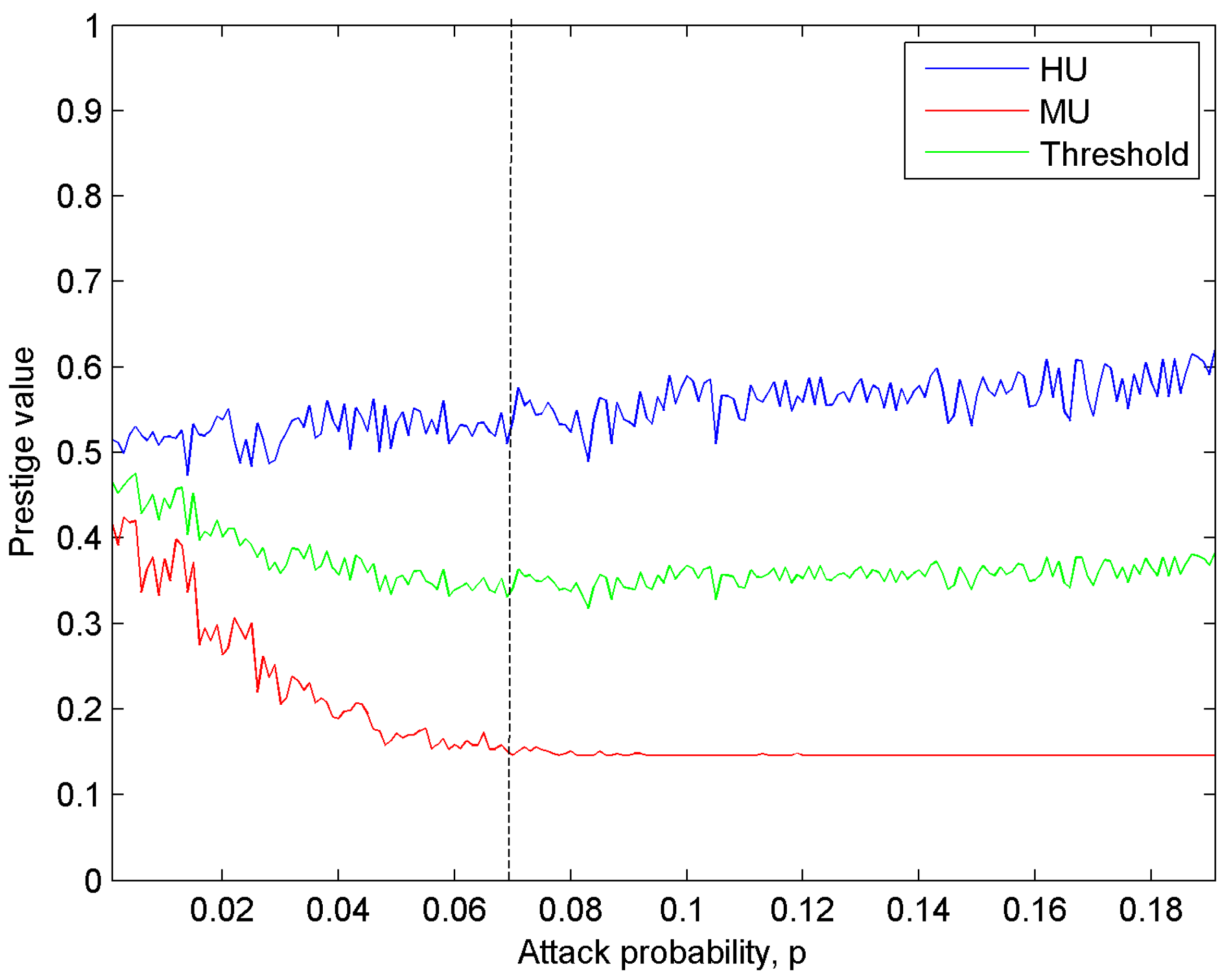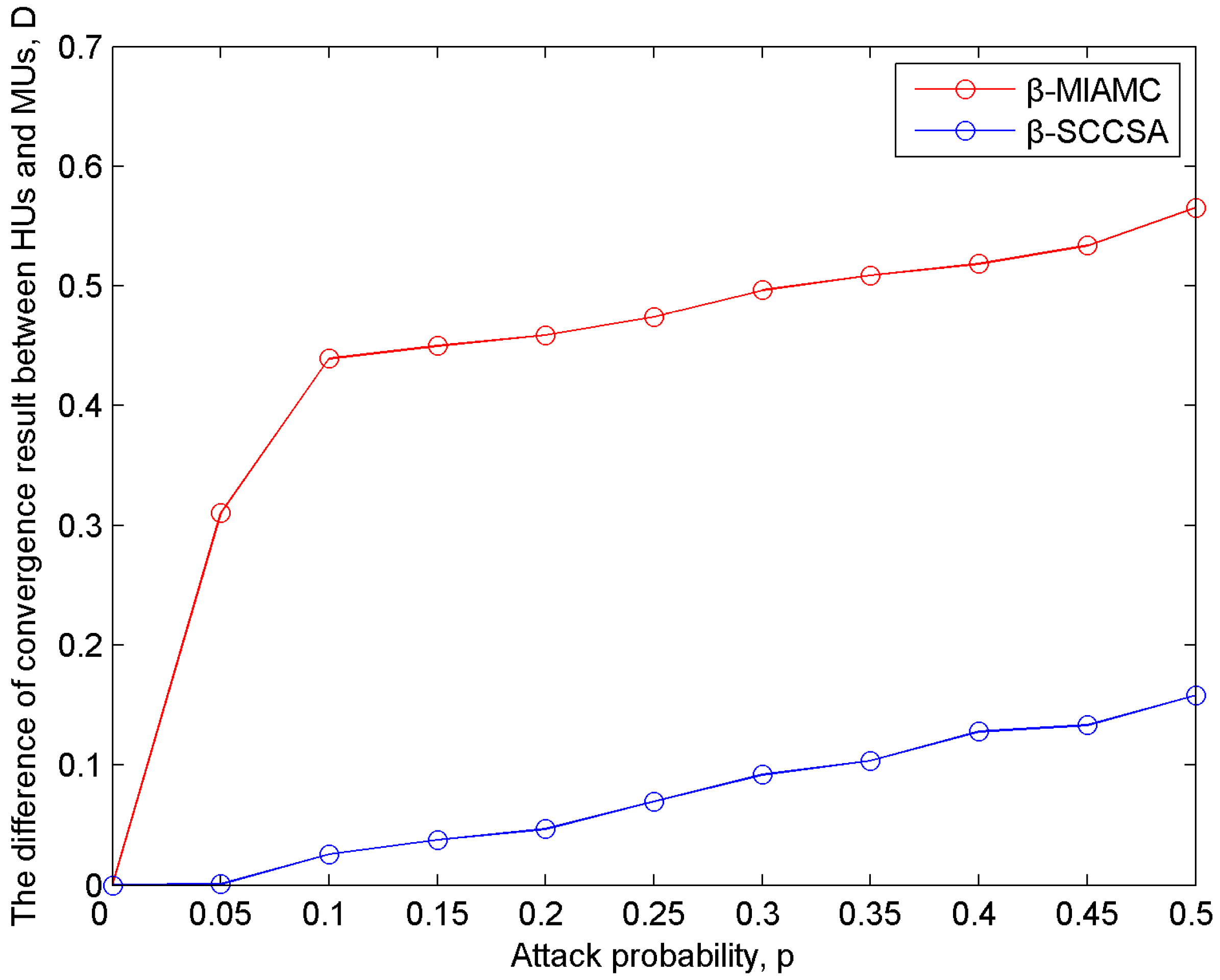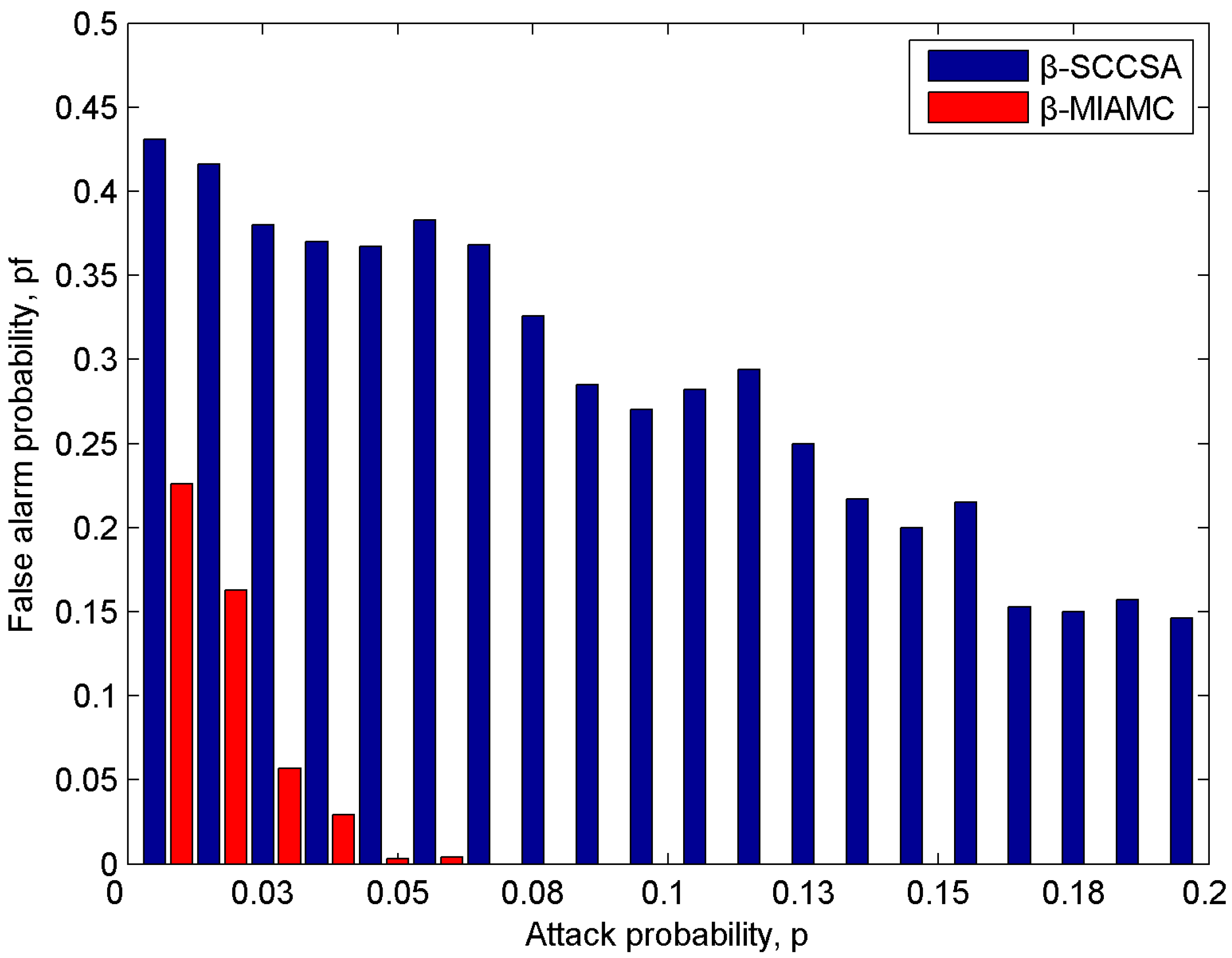1. Introduction
Spectrum sensing is a key link of cognitive radio and the perceived performance will directly affect the performance of the whole cognitive radio system [
1]. At present, the commonly-used spectrum sensing technologies can be divided into three categories: single-user spectrum sensing, distributed collaborative spectrum sensing, and centralized collaborative spectrum sensing. Single-user spectrum sensing technology can only rely on its own perception results, and thus the problems of hidden terminals exist [
2]. Distributed collaborative spectrum sensing technology can rely on the perception results of neighboring cognitive users to achieve an increased sensing accuracy, but the method will greatly increase the complexity of the terminal design [
3]. The centralized collaborative spectrum sensing technology can greatly improve the perceived precision because it can obtain the perceived result of all the cognitive users in the data fusion center. Furthermore, the demands of the sensing terminal design are not high, [
3] and therefore centralized collaborative spectrum sensing technology has drawn more extensive attention.
In the centralized collaborative spectrum sensing system, the multi-user perceptual architecture of spectrum resources can greatly improve the sensing accuracy of the data fusion center. However, malicious users will seriously affect the reliability of the system, so the real-time monitoring of the reliability of multi-users is a key problem that the centralized collaborative spectrum sensing system needs to solve.
The malicious cognitive users can usually be divided into two categories according to the probability of the malicious cognitive user sending a wrong perceived result. The first category malicious users (I-MUs) refers to those which are caused by equipment failure, causing them to send a wrongly perceived result at a large probability. The second category of malicious users (II-MUs) refers to the cognitive users, who want to deliberately interfere with the normal operations of the system. In order to enhance their own concealment, II-MUs usually send tampered perceived results with a smaller probability. This behavior is called Spectrum Sensing Data False (SSDF) attacks [
4]. In order to interfere with the main user or exclusive bands, these cognitive users tamper with their own perceived results, report tampered spectrum sensing information to the data fusion center, disturb the centralized cooperative spectrum sensing algorithm to determine the true spectral state and reduce the perceived performance.
The traditional fusion algorithm can identify the first category of malicious cognitive users (I-MU) with high attack probability, but can hardly identify the second category of malicious cognitive users (II-MU). In order to improve the reliability of the centralized collaborative spectrum sensing system, it is necessary to solve the SSDF problem. A study [
5] proposed a “stripping onion” approach to combat SSDF attacks, in which the central node of the cognitive radio network compares the suspicious degree of the cognitive user with the detection threshold to identify the malicious cognitive user and rejects the perceived result of the malicious cognitive user from the decision. The algorithm needs prior master knowledge of the channel usage rules, or the ability to detect malicious cognitive users will be severely reduced. However, prior knowledge of channel usage is not readily available in reality. Reference [
6] proposed a weighted order probability ratio test method based on prestige in order to detect malicious cognitive users and achieve reliable spectrum sensing in the joint spectrum sensing process. However, the algorithm needs to know the prior probabilities of each cognitive user’s perceived results, resulting in the computational complexity and communication overhead being too large. Reference [
7] proposed a confidence-based colony multi-ant random walk (CARW) algorithm to identify the malicious cognitive users. This method combines the game theory to establish the behavioral game model between honest cognitive users and malicious cognitive users, and based on this model quantitatively calculating the caution of the microblogging users, this method strengthens the microblogging user behavior characteristics’ ability to distinguish honest users and malicious users. Reference [
8] proposed a single channel centralized spectrum sensing algorithm based on the β-reputation (β-SCCSA) system [
9]. This algorithm determines the cognitive user’s reputation and weight by knowing the cognitive user’s historical performance and can react effectively against malicious cognitive users. However, when a malicious user reduces the attack probability (to improve chances of remaining undetected), the algorithm takes a long time to identify malicious users, or simply cannot identify malicious users.
Based on existing research results and the characteristics of collaborative spectrum sensing, we propose using the β-MIAMC algorithm to solve the problem of malicious user identification when the malicious user attack probability is small. By analyzing the simulation results in the case of a small attack probability, the proposed algorithm can reduce the false alarm probability of malicious users by more than 20%. When the attack probability is greater than 7%, the proposed algorithm can distinguish malicious users with 100% certainty.
2. System Model
In order to deal with the problem of SSDF attack in the centralized collaborative spectrum sensing architecture, we propose a malicious cognitive user identification algorithm based on β function and feedback iterative method. Addressing the shortcomings of the prestige evaluation system under the traditional single channel condition and combining them with the characteristics of multiple sub-channels of collaborative sensing, we propose a prestige evaluation system based on multi-channel cooperation.
2.1. Centralized Collaborative Spectrum Sensing System Model
In cognitive radio systems, centralized collaborative spectrum sensing has drawn extensive attention due to its high perceived accuracy and low complexity of perceived terminals. As shown in
Figure 1, the centralized collaborative spectrum sensing system consists of multiple cognitive users and a data fusion center.
In the cognitive wireless communication system, the available frequency band
B is usually divided into
N copies of non-overlapping sub-channels. During the period of spectrum sensing,
K primary users randomly occupy different sub-channels for communicating (
K is much smaller than
N). In the stage of spectrum sensing, cognitive users typically use the energy detection method [
10] to sense the spectral state and send the perceived results to the data fusion center, before the system enters into the centralized fusion stage.
According to the authenticity of the data transmitted by the cognitive user, we will divide the cognitive users into honest cognitive users (HUs) and malicious cognitive users (MUs). Malicious cognitive users tamper with local perceived results to the data fusion center and with the development of the perceived technology, the malicious cognitive users increase its degree of concealment by reducing the attack probability. This makes it difficult to quickly and correctly identify malicious cognitive users, thereby reducing the perceived performance [
11,
12]. Therefore, it is an urgent problem to identify malicious cognitive users accurately and efficiently in the case of high concealment of malicious cognitive users.
2.2. β Reputation System
By building a reputation system for all the cognitive users in the system, it is possible to effectively identify the hidden malicious users based on their historical data.
In order to mathematically model the system, we define the cognitive user sending to the fusion center as a dichotomy process with two possible outcomes {x, y}, where x indicates that the cognitive user sends the true local perceived result to the data fusion center and y indicates that the cognitive user performs a SSDF attack.
Considering that the β-probability density function is usually used to describe the probability distribution properties of the two events and the dichotomy process [
13], we use this mathematical model to construct the β-reputation system. We supposed that
r represents the number of occurrences of the result
x observed and s represents the number of occurrences of result
y. For the probability of
x (
) produced by the dichotomy following the β distribution, the probability density function can be expressed as:
where
;
represents Gamma function; while β-distribution’s parameters are
,
and
,
. The expectation of the β-distribution is:
where
represents the average probability of the occurrence of the result
x in the future after the number of occurrences of
r and
s of the observed results
x and
y are given. Since the first order variable
is continuous, for any given value of
, the second order variable
is negligible and meaningless. Therefore, the expected
of
is usually used to calculate the prestige.
2.3. Prestige Evaluation System in Spectrum Sensing
In order to effectively identify the second type of malicious users hidden in the centralized collaborative spectrum sensing system model, the β reputation evaluation system is usually used to analyze the cognitive users’ reliability in the data fusion center. Currently, the cognitive user prestige building algorithm based on single channel decision is used and the system model of this algorithm is shown in
Figure 2.
Figure 2 shows for the specific channel
, the data fusion center analyzes each cognitive users’ perceived results of the channel in the system, before obtaining the confidence model of the cognitive users’ perceived results for this channel. This method is more effective for finding the type of malicious users who interfere with a particular channel, although it is difficult to use this to accurately identify malicious users who are highly concealed.
SSDF attacks can be divided into three forms: false alarm attack, missed detection attack and probability attack in the process of centralized collaborative spectrum sensing [
14]. In practice, the malicious cognitive users with the purpose of interfering with the sensing system usually use probabilistic attacks. In order to increase their concealment, malicious cognitive users generally attack with a method that randomly selects the channels. Broadband cognitive wireless communication systems typically divide spectrum resources into several independent sub-channels. In the same perceived interval, each cognitive user’s perceived result on the different sub-channel should be correlated. Therefore, it is possible to more accurately distinguish hidden malicious cognitive users by comprehensively assessing the perceived results of cognitive users on multiple sub-channels. We propose a cognitive user reputation-building algorithm based on multi-channel collaboration. The algorithm uses the β-function and the feedback iteration for calculating, before integrating the perceived results of each cognitive user on each sub-channel. We modelled the reliability of cognitive user perceived results as a whole, using the system model of the algorithm shown in
Figure 3.
In this system model, the data fusion center carries out the information fusion according to the plurality of cognitive users’ perceived results on each sub-channel in order to calculate the optimal estimate of the occupied state of different sub-channels. After this, we adjust the reputation value of cognitive users by comparing the data provided by each cognitive user with the optimal estimate value. After the data accumulates for a certain period of time, the data fusion center can distinguish the hidden malicious cognitive users.
3. Malicious User Identification Algorithm
We used the calculated prestige value to determine whether the cognitive user is a malicious cognitive user. Before discussing the malicious cognitive user identification algorithm based on multi-channel collaboration, we defined that the number of cognitive users in the system is J; the data fusion center assigning data depth to each cognitive user is L; and the initial reputation value of each cognitive user on each sub-channel is (where j represents a cognitive user and n represents a sub-channel).
Taking the lth spectrum sensing interval as an example, the algorithm is calculated as follows:
The reputation value of the cognitive user
j on the
nth sub-channel is
. According to Equation (3) we can calculate the weight of cognitive user
j on the
nth sub-channel:
We combined this with the prestige value of the cognitive user on the sub-channel and the local perceived result of each cognitive user
at this perceptual interval. Using Equation (4), we calculate the estimated state of each sub-channel:
where
is the perceived result of the cognitive user
j to the state of the sub-channel
n. Comparing the estimated state
of the sub-channel
n on the perceived gap
l with the majority decision threshold
to obtain the actual state
of the sub-channel
n on the perceived gap
l, we obtain:
This
is used as the element to get the perceived vector
. Calculating the sum of the difference between the perceived results of the cognitive users on the sub-channels and the real state of the sub-channels, we obtain:
Using the mean of the sum of the perceived deviation of the cognitive users on all sub-channels as the threshold of the perceived deviation, we obtain:
By comparing the perceived result’s deviation of the cognitive user with the deviation threshold, it is possible to obtain a positive or negative evaluation
of the cognitive user at this perceived gap as follows:
In this equation, indicates that the cognitive user j has made a positive contribution in the process of determining the channel state. On the contrary, indicates that the cognitive user j has made a negative effect in the process of determining the channel state.
It has been assumed that the data fusion center’s maximum storage length to the cognitive user evaluation history record
is
L. Essentially, the data fusion center can only store the cognitive users’ evaluations that are obtained from
L perceived gaps. Using the historical evaluation of cognitive users to calculate the positive total evaluation
and the negative total evaluation
at the perceived gap
l, we obtain:
where
is the forgetting factor used to reflect the dynamic characteristics of the prestige system [
15].
controls the forgotten rate of the historical evaluation. A smaller
indicates a smaller influence of historical evaluation on the total evaluation and vice versa. The reputation value of the honest cognitive user that occasionally makes wrong sensing can be gradually returned to normal by the later good performance. The prestige parameters
and
of the prestige system can be expressed as:
Based on the prestige parameters of the cognitive user
j on sub-channel
n, the reputation value of the cognitive user
j on the sub-channel
n can be updated to
:
This reputation value is used to calculate the weight parameter of the cognitive user j on each sub-channel in the next perceived gap.
The pseudo-code of this algorithm can be expressed as follows:
| Algorithm Malicious user identification algorithm under multi-channel cooperative conditions |
1: For l = 1 to G /*G is the perceived depth*/
2: do For j = 1 to J
3: do For n = 1 to N
4: do Calculate the weight value of the user on different channels
5: Consolidate the user‘s perceived results
6: if
7:
8: else
9:
10: end if
11: Calculate the deviation of the cognitive user on all subchannels
12: Calculate the mean of all cognitive user deviations
13: if
14:
15: else
16:
17: end if
18: Calculate the reputation parameter
19: Calculate the user's reputation at the next interval
20: end for
21: end for
22: end for |
5. Conclusions
We mainly studied the security problem of centralized collaborative spectrum sensing under SSDF attacks. In order to solve this problem, we established a model of a malicious user identification system with multi-channel cooperation. The model uses the characteristics of cognitive users having the same performance on the different sub-channels in the same perceived gap. This model then collaborates the cognitive user’s perceived results on multi-channels and reduces the probability of misjudgment.
On this basis, we propose a malicious user identification algorithm under multi-channel cooperative conditions that are based on the β-function and the feedback iteration mathematical method. The cognitive user’s prestige value is updated by feedback iterations and the malicious user is distinguished according to the prestige value. The simulation results show that when the attack probability is the same, the β-MIAMC algorithm proposed in this paper can identify the malicious users more accurately than the traditional algorithms. The proposed algorithm reduces the false alarm probability of malicious users by more than 20%. When the attack probability is greater than 7%, the proposed algorithm can distinguish the malicious users with 100% certainty.
